2016--地球 宇宙和空间科学(主题一)
- 格式:ppt
- 大小:4.38 MB
- 文档页数:30

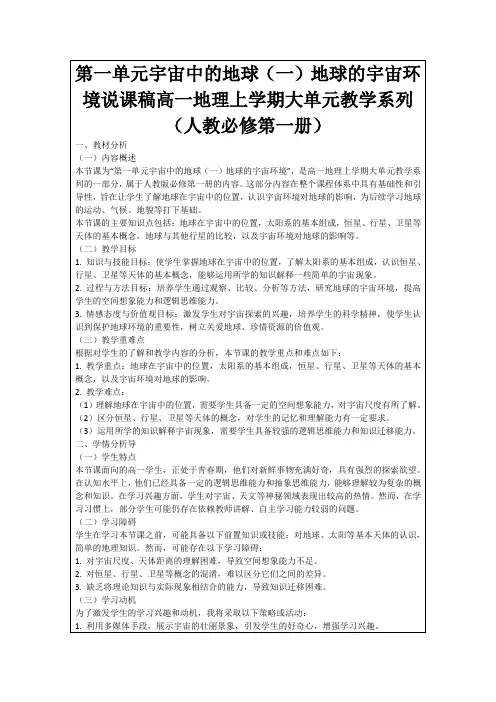
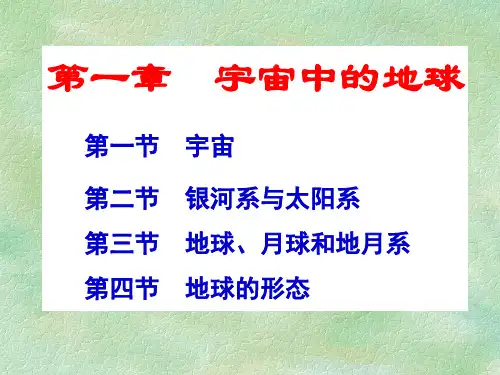
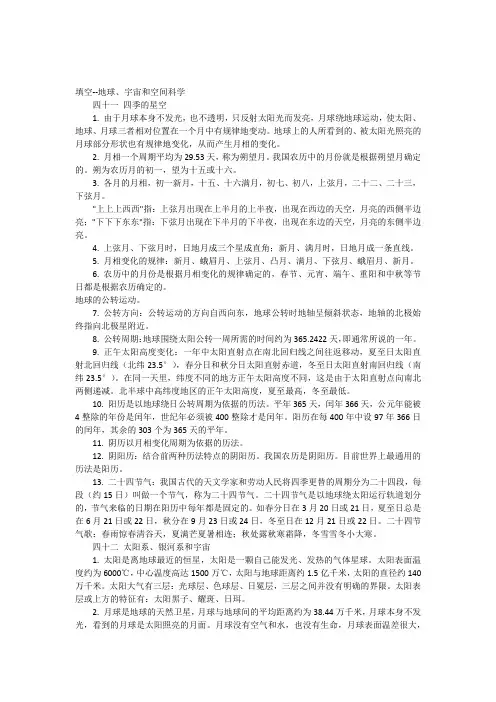
填空--地球、宇宙和空间科学四十一四季的星空1. 由于月球本身不发光,也不透明,只反射太阳光而发亮,月球绕地球运动,使太阳、地球、月球三者相对位置在一个月中有规律地变动。
地球上的人所看到的、被太阳光照亮的月球部分形状也有规律地变化,从而产生月相的变化。
2. 月相一个周期平均为29.53天,称为朔望月。
我国农历中的月份就是根据朔望月确定的。
朔为农历月的初一,望为十五或十六。
3. 各月的月相,初一新月,十五、十六满月,初七、初八,上弦月,二十二、二十三,下弦月。
"上上上西西"指:上弦月出现在上半月的上半夜,出现在西边的天空,月亮的西侧半边亮;"下下下东东"指:下弦月出现在下半月的下半夜,出现在东边的天空,月亮的东侧半边亮。
4. 上弦月、下弦月时,日地月成三个星成直角;新月、满月时,日地月成一条直线。
5. 月相变化的规律:新月、蛾眉月、上弦月、凸月、满月、下弦月、蛾眉月、新月。
6. 农历中的月份是根据月相变化的规律确定的,春节、元宵、端午、重阳和中秋等节日都是根据农历确定的。
地球的公转运动。
7. 公转方向:公转运动的方向自西向东,地球公转时地轴呈倾斜状态,地轴的北极始终指向北极星附近。
8. 公转周期:地球围绕太阳公转一周所需的时间约为365.2422天,即通常所说的一年。
9. 正午太阳高度变化:一年中太阳直射点在南北回归线之间往返移动,夏至日太阳直射北回归线(北纬23.5°),春分日和秋分日太阳直射赤道,冬至日太阳直射南回归线(南纬23.5°)。
在同一天里,纬度不同的地方正午太阳高度不同,这是由于太阳直射点向南北两侧递减。
北半球中高纬度地区的正午太阳高度,夏至最高,冬至最低。
10. 阳历是以地球绕日公转周期为依据的历法。
平年365天,闰年366天,公元年能被4整除的年份是闰年,世纪年必须被400整除才是闰年。
阳历在每400年中设97年366日的闰年,其余的303个为365天的平年。

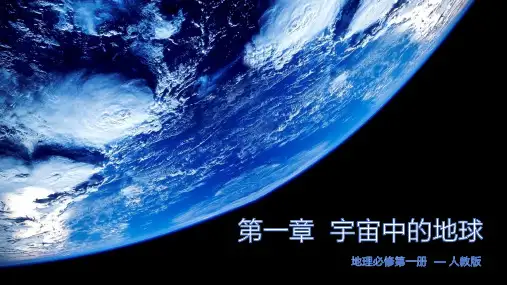
第一章宇宙中的地球地理必修第一册—人教版火星基地应该是什么样子特殊的家园——地球上存在生命的条件安全的宇宙环境稳定的太阳光照液态水的存在适宜的温度适合生物生存的大气外部内部太阳系中,除地球外火星被认为是最适合人类居住的星球。
人类探测已经持续多年从20世纪60年代开始,人类向火星发射探测器,开启了火星探测之旅。
科学家设想在火星上建立人类定居点。
12太阳系 中最合适探索移民外星球地球资源的有限性随着人口的增长和经济的发展,地球上的资源日益紧张,包括食物、水和能源等基本生存资源。
为了寻找更多的资源,人类不得不将目光投向太空,寻找新的资源和生存环境。
地球环境的恶化随着工业化和现代化的进程,地球的环境问题日益严重,包括气候变化、资源枯竭、污染等,这些问题威胁到人类的生存和发展,寻找一个新的家园,成为了一个紧迫的任务。
人类对于生存空间的渴望太空探索不仅能够满足人类的探索欲望,同时也是为了人类的未来发展和生存考虑。
通过移民外星球,人类可以开拓新的生存空间,同时也为地球上的问题提供解决方案。
美国在2020年7月30日发射了探索火星的“毅力”号,先后发现了大量有机分子——被认为是生命组成部分的含碳分子,这些物质的发现或使火星干涸的河流三角洲地区成为寻找生命的理想之地、大量有机物,这将有助于揭示火星是否存在生命这一问题、在火星的火山口发现有机物的痕迹,这为科学家们提供了火星上可能存在生命的重要信息。
天问一号于2020年7月23日在文昌航天发射场由长征五号遥四运载火箭发射升空于2021年5月15日成功实现软着陆在火星表面。
2021年5月22日,祝融号火星车成功驶上火星表面,开始巡视探测。
天问一号在火星上次实现通过一次任务完成火星环绕、着陆和巡视三大目标,对火星的表面形貌、土壤特性、物质成分、水冰、大气、电离层、磁场等的科学探测。
火星表面的自然状况01STEP 火星基地应具备的基本的生命保障条件02STEP 人类目前在生物圈研究领域的成就03STEP 分析火星基地的基本功能04STEP火星表面的自然状况⚫火星,是距离太阳第四近的行星,也是太阳系中仅次于水星的第二小的行星,为太阳系里四颗类地行星之一。
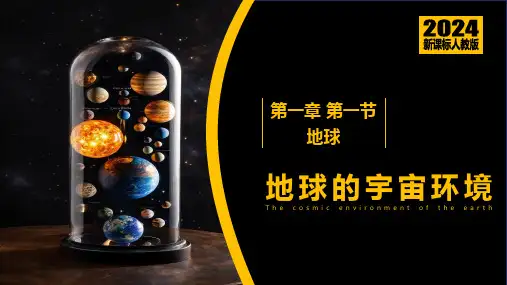
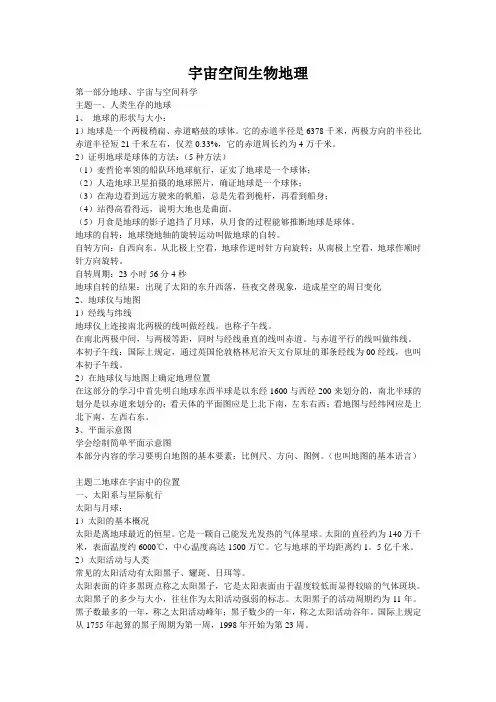
宇宙空间生物地理第一部分地球、宇宙与空间科学主题一、人类生存的地球1、地球的形状与大小:1)地球是一个两极稍扁、赤道略鼓的球体。
它的赤道半径是6378千米,两极方向的半径比赤道半径短21千米左右,仅差0.33%,它的赤道周长约为4万千米。
2)证明地球是球体的方法:(5种方法)(1)麦哲伦率领的船队环地球航行,证实了地球是一个球体;(2)人造地球卫星拍摄的地球照片,确证地球是一个球体;(3)在海边看到远方驶来的帆船,总是先看到桅杆,再看到船身;(4)站得高看得远,说明大地也是曲面。
(5)月食是地球的影子遮挡了月球,从月食的过程能够推断地球是球体。
地球的自转:地球绕地轴的旋转运动叫做地球的自转。
自转方向:自西向东。
从北极上空看,地球作逆时针方向旋转;从南极上空看,地球作顺时针方向旋转。
自转周期:23小时56分4秒地球自转的结果:出现了太阳的东升西落,昼夜交替现象,造成星空的周日变化2、地球仪与地图1)经线与纬线地球仪上连接南北两极的线叫做经线。
也称子午线。
在南北两极中间,与两极等距,同时与经线垂直的线叫赤道。
与赤道平行的线叫做纬线。
本初子午线:国际上规定,通过英国伦敦格林尼治天文台原址的那条经线为00经线,也叫本初子午线。
2)在地球仪与地图上确定地理位置在这部分的学习中首先明白地球东西半球是以东经1600与西经200来划分的,南北半球的划分是以赤道来划分的;看天体的平面图应是上北下南,左东右西;看地图与经纬网应是上北下南,左西右东。
3、平面示意图学会绘制简单平面示意图本部分内容的学习要明白地图的基本要素:比例尺、方向、图例。
(也叫地图的基本语言)主题二地球在宇宙中的位置一、太阳系与星际航行太阳与月球:1)太阳的基本概况太阳是离地球最近的恒星。
它是一颗自己能发光发热的气体星球。
太阳的直径约为140万千米,表面温度约6000℃,中心温度高达1500万℃。
它与地球的平均距离约1。
5亿千米。
2)太阳活动与人类常见的太阳活动有太阳黑子、耀斑、日珥等。

第一章宇宙中的地球地球所处的天系统统,依据从低到高的级别,挨次为地月系、太阳系、银河系和可观察宇宙。
地球是太阳系中一颗既一般又特别的行星,它是太阳系行星中独一有高级智慧生命的星球。
太阳辐射是地球光和热的主要源泉,保持着地表温度,是地球上水、大气运动和生命活动的主要动力。
太阳活动开释大批的物质和能量,扰动地球的磁场和大气层,给人类活动带来好多不利影响。
对地层和化石的研究是认识地球历史的主要门路。
地球的演化历史可分为前寒武纪、古生代、中生代和重生代,此中重生代是人类出生的时代。
地球的内部圈层包含地壳、地幔和地核。
上地幔的上部存在软流层。
上地幔顶部和地壳合称岩石圈。
地球的外面圈层包含大气圈、水圈和生物圈,它们和岩石圈互相联系、互相浸透,共同构成人类赖以生计和发展的自然环境。
学习本章内容,能够运用天文仪器、简略教具等,察看、辨别、描绘与宇宙、太阳、地球等有关的自然现象;具备必定的运用观察、实验、检查等方式进行科学研究的意识和能力(地理实践力)。
能够运用宇宙科学的基础知识,说明一些天文现象之间的关系和变化过程(综合思想)。
能够在必定程度上合理描绘和解说特定地区的自然现象,并说明其对人类的影响(地区认知、人地协调观)。
与本章知识有关的名校及专业《中国大学及学科专业评论报告(2017—2018)》天文学类专业大学排名排名学校名称星级1南京大学★★★★★2中国科学技术大学★★★★3北京师范大学★★★4北京大学★★★5中国科学院大学★★★与本章知识有关的名人及职业课标内容第一节地球的宇宙环境中心修养目标察看、辨别、描绘天体特色,具备必定的科学研究的意识和能力。
【地理实践力】运用资料,描绘地球所处的 2.能够描绘地球在不一样的宇宙空间尺度中的地点。
【地区认知】宇宙环境 3.能够运用天系统统层次,说明不一样天体之间的关系。
【综合思想】4.建立宇宙是物质的和运动的科学宇宙观。
【人地协调观】知识清单调地球在宇宙中的地点天体观点:宇宙间物质的存在形式。

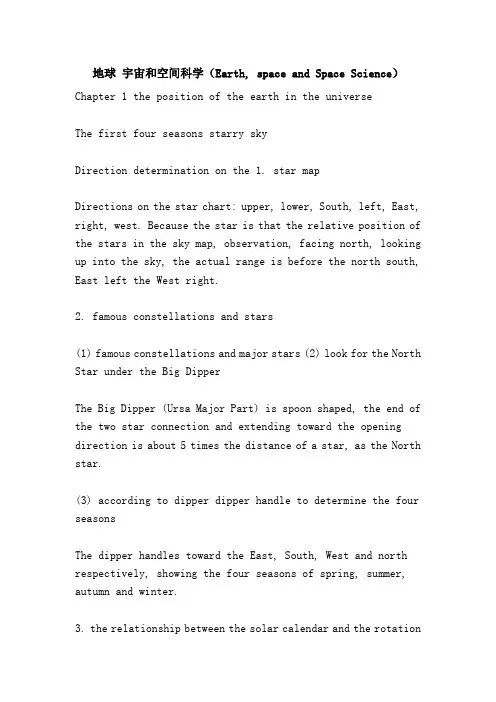
地球宇宙和空间科学(Earth, space and Space Science)Chapter 1 the position of the earth in the universeThe first four seasons starry skyDirection determination on the 1. star mapDirections on the star chart: upper, lower, South, left, East, right, west. Because the star is that the relative position of the stars in the sky map, observation, facing north, looking up into the sky, the actual range is before the north south, East left the West right.2. famous constellations and stars(1) famous constellations and major stars (2) look for the North Star under the Big DipperThe Big Dipper (Ursa Major Part) is spoon shaped, the end of the two star connection and extending toward the opening direction is about 5 times the distance of a star, as the North star.(3) according to dipper dipper handle to determine the four seasonsThe dipper handles toward the East, South, West and north respectively, showing the four seasons of spring, summer, autumn and winter.3. the relationship between the solar calendar and the rotationof the earth(1) the rotation of the earth produces four seasons, with a period of 365.2422 days.(2) the basis of solar calendar day and month time;The number of solar calendar days is based on the cycle of seasons and the speed at which the earth revolves around the sun. The seasonal cycle is 365.2422 days, the size of the month, month for 31 days, I was 30 days; February year for 28 days, 29 days in a leap year.(3) the arrangement of solar calendar leap yearThe fractional portion of the cycle of alternate seasons (O.2422 days) equal to garlic. Therefore, in the Gregorian calendar every 400 years in 97 366 years (leap year) the rest of the 303 years, 365 days (year). In A.D., divisible by 4 is a leap year, and century must be divisible by 400. It is a leap year.4. with the lunar moon(1) the meaning of the moonVarious lunar moon form called moon.(2) the causes of phase changeThe moon is an opaque, non luminous sphere.The relative positions of the sun, the earth, and the moon vary regularly over a period of three months.(3) the name and appearance time of judgmentWhen the moon, the moon and the earth are in the same line, when the moon is centered, it is a new moon. The time is the first day of the lunar year. When the earth is centered, it is full moon (hope), and the time is fifteen and sixteen of the lunar calendar.The day, month, the three mutually perpendicular, the other side, when the motion of the moon the moon, time for the lunar seventh moon, eight; Japan, middle exercise for the moon, time for the lunar twenty-two, twenty-three.YuexiangThe phase change cycle of 29.53 days.(4) the arrangement of the lunar month, the middle of the lunar month. About 30 days, I was 29 days, the size of the month and distribution, so the way to arrange and keep the Gregorian calendar month.5. reasons for the formation of eclipses(1) the meaning of solar eclipse and lunar eclipseAs the moon blocks our view of the sun, a solar eclipse occurs;the moon enters the earth's shadow, and we see the lunar part or all of the moon's surface darkening, creating a lunar eclipse.(2) the cause and time of solar eclipse and lunar eclipseThe sun, moon, and ground are just right or near in a straight line, and the eclipse occurs when the moon is centered. Therefore, eclipses always occur on new moon (Lunar New Year's day).Lunar eclipse occurs when the earth is centered. An eclipse of the moon must occur at the full moon (lunar calendar fifteen, sixteen).(3) the type of solar eclipse and lunar eclipseThe solar eclipse is divided into a total solar eclipse, the partial eclipse, eclipse eclipse is divided into three categories; two, total lunar eclipse eclipse.(4) of the total solar eclipse, the total lunar eclipseThe process of total solar eclipse is the process of shading the moon's shadow from right to left. The right side of the moon is darkened first, and the range is gradually expanded. All the blocks are blocked and the right side of the moon is lit up until the end of the total eclipse.The process is a total lunar eclipse lunar left (East) before dark, all the dark, after the first light left until the endfor total lunar eclipse. The two phase change process in the figure, as long as the moon's shadow to make clear the relationship between direction and is easy to understand.(5) the lunar eclipse does not happen every monthThe orbital plane of the moon moving around the earth and the orbital plane of the earth moving around the sun have a 5. The angle between the left and right, so the lunar eclipse doesn't happen every month.The second solar system and interplanetary navigation1. the sun and the moon(1) the basic situation of the sunThe sun is the nearest star to the earth. It is a luminous, hot gas star, about 1 million 400 thousand kilometers in diameter, the surface temperature of about 6000 degrees, the central temperature of up to L500 million degrees, the daily distance of about 150 million km. The earth moves around the sun at the same time as it rotates. It takes a year to revolve around the sun.(2) the basic survey of the moonThe moon is the only natural satellite of the earth. On average distance of about 384 thousand and 400 km, the moon is about 3476 km in diameter, the moon has no light of its own. The dark part of the moon is the plains and lowlands of the moon's surface,and the bright part of the moon belongs to the highlands and mountainous regions of the moon's surface. The moon has numerous craters. The moon's orbit around the earth is about a month, and it rotates at the same time. The cycle is exactly one month, so the moon we see on earth is the same face.2. the influence of solar activity on human beings(1) the types of common solar activityThere are sunspots, flares and prominences. Sunspots occur in the photosphere, prominences and flares occurred in the chromosphere.(2) sunspot cycle;The sunspot cycle is 11 years, and the number and size of sunspots are often signs of solar activity. The sunspot year is the solar maximum; the minimum sunspot number is the Solar Valley year.(3) the influence of solar activity on the earthAffect short wave communication on earth.Too much ultraviolet light cause damage to human skin.Influence the climate of the earth.Influence the earth's magnetic field, the compass can not correctly indicate the direction.3. solar system(1) the composition of the solar systemNine planets, asteroids, comets and other celestial bodies orbit around the sun in a certain orbit, forming the solar system. The sun is the central celestial body, which attracts all the celestial bodies of the solar system with its powerful gravitational attraction around it, making them rotate around themselves in an orderly manner.(2) from the date of the order from the near to the distant planetsThe distance on the order from the near to the distant planets Mercury, Venus, earth, Mars, Jupiter, Saturn, Uranus, Neptune and pluto.Mercury, Venus, earth, and Mars are called terrestrial planets, consisting mainly of stone and iron, with smaller radii but smaller masses, but with higher densities.Jupiter, Saturn, Uranus, and Neptune are called Jovian planets, consisting mainly of hydrogen, helium, ice, methane, ammonia, etc., and are much larger in quality and radius than in the earth, but are less dense.Pluto is a special planet. It is the outermost planet in the solar system.(3) the location of the asteroid beltAsteroids, located between Mars and Jupiter's orbit, do not see these asteroids with their naked eyes. They orbit around the sun in an elliptical orbit, forming an annular asteroid belt.(4) the direction of the revolution of the nine planetsThe nine planets revolve from west to East, and orbit almost on the same plane. The orbit is very close to that of the circle.(5) meteor phenomena, meteorites;Meteor phenomenonWhen a solid block of solar system enters the atmosphere, it rubs against the atmosphere, burns and lights the night sky, known as meteor.No meteoroids burned down to the earth surface, the meteoroid meteorite called. Meteorites mainly composed of rocks are called meteorites. It gives us a wealth of information about the formation and evolution of solar system objects, and is an excellent source of scientific research. By calculating the isotopic content of various elements in meteorites, we can calculate the age of meteorites, thus calculating the period when the solar system began to form. The famous Jilin meteorites, meteorites have Chinese China Xinjiang aerosiderite, Bahrain Jie, Australia Moqixun carbonaceous meteorite meteorite.Meteor showerMeteoroids originally move around the sun, and when they pass through the earth, they change their orbits by the forces of the earth and enter the earth's atmosphere. Many meteors disperse from one point of the sky (radiation point) to form a meteor shower.Comet 4.(1) the meaning of cometA comet is a smaller mass of heavenly bodies orbiting the sun on a flat long orbit,A cloud shaped appearance.(2) the composition of cometsA large ice hockey ball consisting of fragments of rock, solid particles, and ice crystals".(3) revolution cycle of Halley's cometHalley's comet is the most famous comet, with a revolution of 76 years.5. the human journey to space and the exploration of the moon and planets by man(1) the human journey to spaceTime eventIn 1957, the Soviet Union successfully launched the world's first man-made earth satellite, marking the opening of spaceIn 1961, the Soviet Union successfully launched a manned spaceship for the first time, and Gagarin became the first astronaut to travel in spaceIn 1981, the United States successfully launched its first manned space flight, the Columbia, and human exploration of the universe entered a new phaseIn 1993, Russia and other countries began to build the international space station, human spaceflight activities into a new era(2) human landing on the moonTime eventIn 1959, the Soviet Union's lunar probe 2 successfully landed on the ground for the first timeIn 1961, the United States announced the implementation of the Appollo manned lunar landing programIn 1968, the U. S. "Appollo" 8 manned spacecraft successfully flew around the moon for the first timeIn 1969, American astronaut Armstrong first stepped on the moon,the first successful lunar landing(3) great events of human exploration of mercury, Mars, and VenusTime event1989 in May, the American space shuttle sent the Magellan probe into spaceIn April 2001, the United States launched the Odyssey Mars probeIn 2003, the European Space Agency Mars Express Mars probe was launchedIn 2003, the Mars rover rover, carrying the Mars rover, launched into the airIn 2003, America's "courage" twin, the "opportunity" rover, was launchedIn 2004, the American messenger mercury probe took the delta 2 rocket to orbit mercury6., the achievements of China's space industryTime eventIn 1960, China successfully launched its first home-made launch vehicleIn 1970, the "Dongfanghong" man-made satellite was successfully launched, marking China's high flying spaceIn 1975, China successfully launched the first recoverable satellite, becoming the third country in the world to master the technology of satellite returnIn 1985, the long march series of launch vehicles took part in international competition and launched satellites for other countriesFrom 1991 to now, the Shenzhou spacecraft was launched, in which the Shenzhou five manned spaceship was launched in 2003, and China became the third country in the world to send astronauts into space independentlyThird sections of the Milky way and the universe1. universe(1) the composition of the Milky Way GalaxyThe Milky Way galaxy is a massive celestial system composed of numerous stars and interstellar materials.(2) size and shapeThe galaxy is discus shaped from side to side, overlooking the whirlpool. The Milky way is about 100 thousand light-years across.(3) the position of the solar system in the galaxyThe solar system, near the equatorial plane of the galaxy, about 30 thousand light-years (1 light-years from about 94605 kilometers) away from the center of the Milky way, is the central movement of the solar system as an ordinary star around the galaxy. There are about 200000000000 stars in the Milky way, such as the sun.2. the composition of the universeAt present, there are about 1 billion celestial bodies similar to those observed by the Milky way. These celestial systems are called galaxies, and all galaxies form a vast universe. The cosmic part of man's observation is called the total galaxy, which is about 15 billion light-years away from the earth.Within this range, the system is composed of several levels of celestial bodies, as follows:3. the origin and evolution of the universe(1) Harbert discovered the characteristics of Galaxy motionAll galaxies are far away from us. The farther away galaxies are, the faster they move. The distance between galaxies is constantly expanding.(2) the Big Bang TheoryAbout 15 billion years ago, the universe we were in was squeezedin a primordial fireball in the form of particles, very high densities and temperatures. The universe was born in the explosion of this big fireball.The explosion caused the expansion of the universe, which has continued to this day and continues.4. the history of the development of the heliocentric geocentric saidTime person, main theory, theoryIn second Century, the Greek scientist Ptolemy founded the "geocentric". The theory holds that the earth is the center of the universe, and that the sun and other celestial bodies revolve around the earthSixteenth Century Poland astronomer Copernicus based on the data of a large number of precision, established the "heliocentric" universe theory, that the sun is the center of the universe, the earth and the planets rotate around the sunEighteenth Century Laplasse "Laplasse Kant Kant nebula" said that the solar system was formed from a nebula contraction, first is the formation of the sun, and then the remaining Nebula material further shrinkage evolution, the formation of the earth and other planets5. evolution of stars(1) starsA globular or spherical object consisting of glowing gas that glows and warms itself; called a star. The distance between a star and the earth is far away. The nearest star is the sun (its light takes 8 minutes to reach the earth), followed by the Centauri (its light reaches the earth about 4.2 light-years).(2) special starsSupernova: a new star whose brightness has risen to more than 10 million times. It is the most violent eruption of stars.The explosion results in the complete collapse of a star into a nebula, or ejection of most of its mass, leaving some of its remaining material to shrink into white dwarf stars, neutron stars, or black holes, leading to the final stage of stellar evolution.In the Milky Way department, has found four supernovae, which, in 1054 the supernova is the most famous, the Crab Nebula is a recently discovered remains of a supernova.(3) the future evolution of the sun(4) the evolution of stars6. the evolution of the earth and the birth of life(1) the evolution of the earthTime evolution4 billion 600 million to 2 billion 600 million years ago, as the earth's temperature dropped, the solid crust gradually formed. A large quantity of water vapor released by the eruption of a high temperature magma. As the temperature falls, condensed water drops to the earth's surface and the earth enters the ocean age. Scientists speculate that 3 billion 800 million years ago, the most primitive body of life was born in the ocean2 billion 500 million years ago, 2 billion 500 million to 600 million years ago, the earth began to appear large tracts of land and mountains, the algae in the ocean release oxygen, oxygen content in the atmosphere gradually increasedFrom 600 million to 250 million years ago, the land area of the Paleozoic earth increased, and the primitive Eurasian and North American continents appeared above the sea, and insects, fish, amphibians, bare ferns and other organisms appearedThe Mesozoic the Atlantic and India oceans formed from 250 million to 70 million years ago, and the outline of the Chinese mainland was basically formed. Gymnosperms and reptiles appeared70 million years ago, the earth experienced a large-scale orogeny in the third century, forming many large mountains in the world, such as the Himalaya mountains, birds, mammals and angiosperms(2) the birth process of lifeThe original atmospheric methane, ammonia, water, hydrogen and carbon dioxide in the cosmic rays, ultraviolet radiation, lightning under the effect of synthetic amino acids, nucleic acids, sugars and other organic compounds, these substances together in the original ocean, after a long and complex chemical changes, the formation of protein and nucleotide molecules, under certain conditions, after concentration, cohesion, the formation of a system composed of many molecules, a layer of film outside, in the original ocean has undergone changes long and complex, and ultimately the formation of primitive life.The eleventh chapter, human survival of the earthThe first section of the earth1. the shape and size of the earth(1) the earth is an ellipsoidThe earth is an ellipsoid with a slightly flattened edge and a slightly bulging equator.The equatorial radius of the earth is 6378 km, and the equatorial circumference is about 40 thousand km.(2) the method of proving that the earth is a sphereGlobal voyages by Columbo, Magellan and other famous navigators, and photographs of earth taken on artificial satellites.2. globe and map(1) meridians and parallelsLongitude: the line connecting the north and south poles on the globe is the longitude line.The latitude: on the globe and the line is parallel to the equator.The equatorial equatorial weft is the longest, about 40 thousand km long.The prime meridian: after the London Greenwich observatory site 0. The warp, also called the prime meridian.The graticule: warp and weft woven into the network, called Jingwei network. You can determine the location of any point on the earth surface using graticule.(2) to determine the location on the globe and mapA longitude and latitude can only determine a point on the earth's surface position, a point on the earth's surface is only a longitude.The prime meridian to the East and west each divided into 180. 1800, east to east longitude, usually expressed by "E" (such as 34. E); West 180. Belong to the west, usually represented by "W" (such as 340W).The equator is 0. The latitude, from the equator to the north and south poles were divided into 90.. North of the equator latitude (indicated by "N"), the more north latitude latitude higher value; south of the equator latitude (indicated by "S"), the south latitude value higher latitude. North of the equator in the northern hemisphere, the southern hemisphere is south of the equator. Usually in the 300 and 600 latitude to low latitude, the latitude is divided into mid latitude and high latitude.Schematic diagram of 3. plane(1) scaleOn the map scale is that map distance than the degree of narrowing the distance field. The formula is:(2) directionThe basic direction of the plane eight. The expression of the three kinds of commonly used direction on the map.The expression of direction with the graticule: in latitude and longitude lines on the map, indicating the warp weft indicating north-south direction, east-west direction.The direction indicator expression direction: the map has a pointer to the object, the arrow points to the direction for the North to.In the absence of the latitude and longitude lines and direction on the map, "according to the north of the south, East left the West right" principle to determine the direction.(3) the legendThe legend is said symbols on the map of geographic objects.A common legend is shown in figure.The second section topography and crustal movement1. of the earth's interior structureThe interior of the earth can be divided into the crust, mantle and core layer three.2. crustal movementThe crust is in constant motion. According to the nature and direction of crustal movement, can be divided into horizontal and vertical movement of two types. The level of motion of the surface rock bending uplift occurred in some places, forming a huge fold mountains; some places break open, formed the rift or sea. The vertical motion performance for the crustal uplift or subsidence, which cause the surface of ups and downs and the sea changes.3. plate tectonicsThe theory of plate tectonics the earth surface is divided into several rigid lithospheric plates, subduction and collisionzone, as the plate between the ridges, transform faults and other activities with. The theory of plate tectonics, the earth's surface movement is mainly caused by fault activity between the plates to complete, and the plate boundary between the wide block deformation is very small, can be considered to be rigid plate. The motion of the plates that rigid lithosphere (including the continent and ocean crust) mobile asthenospheric thin viscosity in the upper mantle on the smaller.4. active volcano earthquake distribution and earthquake disaster prevention(1) the main distribution area of the volcano and earthquake in the world(2) earthquake disaster prevention activitiesThe engineering countermeasure: strengthen the seismic capacity of all kinds of engineering.Non engineering countermeasure: establish and perfect the system for disaster reduction, earthquake disaster mitigation planning, development of earthquake prevention and disaster reduction publicity and education and training, scientific research, and promote the exercise of earthquake disaster insurance and disaster relief funds and supplies etc..5. terrain(1) the main topographic featuresA plain ground wide flat, generally at an elevation of 200 meters below the small fluctuation.The mountain high mountains and steep slopes, generally at an elevation of 500 meters above the undulating terrain, relatively large height.The plateau altitude of more than 500 meters above the ground, flat, undulating.The basin surrounded by high, middle low, the terrain is relatively flat.The hills: generally at an elevation of 500 meters below the undulating terrain, gentle slope, relatively small height.(2) simple contour mapThe top 1: closed contour,From extroversion to elevation.The saddle between two from peak to peak, the saddle, the lower elevation.Cliff: adjacent lines overlap and merge.Ridge: contour lines protrude from height to low.Valleys: contours protrude from low to high.Third sections of soil1. structure of soil(1) soil composition;The soil is composed of water, air, minerals and humus.There are a lot of living things in the soil: animals, plants and microorganisms.(2) the type of soil;Effects of soil grain properties on plant growthSandy soil has more sand, less sticky particles, coarse particles, loose, difficult to bond, ventilate, strong permeability, and easy to dry. Organic matter decomposes quickly and tends to drain awayClay soil has less clay particles, fine silt, fine particles, sticky, wet, sticky, dry, hard to maintain water and fertilizer capacity, poor ventilation and permeabilityLoam soil sand, sticky particles, powder sand roughly the same amount, the texture is even, not too loose, nor sticky, ventilation, water permeability, water conservation, fertilizer preservation, suitable for farming(3) the effect of plants on SoilAccumulation process of organic matter. Plants absorb nutrients, synthesize organic matter and accumulate in the parent material.Enrichment process of nutrient elements. Plant roots selectively absorb nutrient elements, store them in organisms and release them to the surface of the soil with the decomposition of biological debris. With the development of biological cycle, nutrient elements are continuously enriched on the surface of soil.2. soil pollution and protectionSoil resources are limited, and human survival and development depend on it. The greatest threat to soil resources is soil pollution and overexploitation.Current situation, harm, treatment measuresSoil and water loss, soil erosion, wide area and large amount of runoff. The soil erosion in the Loess Plateau is especially serious, the degradation of farmland, desertification, flood and waterlogging, ecological deterioration, tree planting and grass planting are comprehensively dealt withSoil desertification, Inner Mongolia, Gansu, Ningxia, Qinghai, Xinjiang and other places are the most serious, arable land decreased, sandstorms frequent, planting trees and grass, rational developmentSoil pollution, soil pollution in China is still deteriorating, the quality of agricultural products decline, endanger human health, prevention based, strengthen management, monitoring and comprehensive treatmentFourth sections of water on earth1. classification of water bodies96.53% of the water on the earth is sea water, and only 2.53% is fresh water. Fresh water can be divided into glacial water, underground fresh water and other water bodies. At present, 0.3% of all freshwater resources can be exploited and utilized by human beings.2. water cycleThe water distributed around the earth is closely linked by a series of processes and processes, such as evaporation, transpiration, water vapor transport, precipitation, infiltration, surface runoff, or subsurface runoff, and so on. Through the mutual transformation of water bodies and water exchange, the water resources can be constantly updated.3. water resources(1) the serious crisis of freshwater resources in the world and China;60% of the world's water resources are scarce and water supply is difficult.Second, China is the world's "poor countries" one, the per capita water resources is only the world average of 1/4. Lack of water supply has seriously affected the local economic development and the people's livelihood.(2) measures for rational development and utilization of water resources;Save water, recycle water and make full use of it.Prevention and control of water pollution and protection of water resources.Third, build reservoirs, cross basin water diversion, change the temporal and spatial distribution of water resources.Fifth, weather and climate1. weather and climate(1) the concept of weatherShort period of time, the atmospheric temperature, humidity, atmospheric pressure and other elements of the integrated status of the weather.Weather phenomenon: sunny, overcast, rain, snow and so on.Weather factors include temperature, air pressure, wind, humidity and precipitation.(2) the concept of climate;Climate is the average or statistical state of an area over the years. The average state is usually expressed by the average or statistic of climatic factors such as temperature and precipitation.Factors affecting the climate include solar radiation, ground conditions, atmospheric circulation and human activities.2. artificial rainfall(1) cold cloud artificial rainfall;。
地球在宇宙中任娅红\陕西省勉县第一中学【课题】必修模块一第一章第一节地球在宇宙中【所需课时】:2节【课标要求及分析】课标要求:描述地球所处的宇宙环境,运用资料说明地球是太阳系中一颗既普通又特殊的行星课标分析:地球在宇宙中,从地球角度分析宇宙,从宏观和微观两个层面理解地球的宇宙环境。
宏观层面上是指地球在天体系统中所处的位置;微观层面上是指地球在太阳系中所处的位置。
了解地球所处的宇宙环境目的是为认识地球是太阳系中一颗既普通又特殊的行星。
根据本条“标准”的要求,学生在分析地球的普通性和特殊性时,要会用有关资料加以说明。
这些资料如太阳系九大行星的比较数据、地球在太阳系中的位置图、地球本身的条件等。
从而也培养学生利用材料分析问题的能力。
【教材及学情分析】教材分析:本节是高中地理的开篇,涉及较多的天文知识,这些内容很容易激发学生的兴趣。
教材设计了典故叙述宇宙环境,教材在介绍天体的具体形式时用了很贴切的形容词,让学生有比较直观的认识。
对于天体系统的层次,教材是以图加材料说明的形式从小范围到大范围来讲述。
为了说明地球的普通性,教材把八大行星的有关数据归纳成图表,引导学生应用数据分析探究,把地球与其他行星进行比较,说明地球是太阳系一颗普通的行星。
而对于本节的重点内容,教材主要从地球与太阳的距离适中、地球的体积和质量适中和八大行星绕日公转的特征,分析地球上具备了生命存在的温度、大气和安全的宇宙环境等条件,说明地球是太阳系中一颗特殊的行星。
本节课后活动的目的是以地球上出现生命的条件作为一个参照,培养学生迁移和应用知识的能力,鼓励学生大胆想象,但要有理论根据。
学情分析:学生已经从各种媒体了解宇宙与地球的相关知识,但多数不系统,更不能聚焦于地球的宇宙环境这个核心上,发散度高。
另外学生对宇宙的充满了好奇,特别是一些地外生命的信息,所以合理引导和正确诠释地球的特殊性很关键,再就是利用学生丰富的宇宙知识开展课堂讨论,有利于学生培养利用资料解释自己观点的能力,对于学生中一些常含糊不清的概念和观点,教学中有必要进行适当的纠正。
关键能力·融会贯通能力1 地球所处的宇宙环境(2016·上海高考)太空中隐藏着无限的奥秘,人类对太空的探索越来越深入……据此回答(1)、(2)题。
(1)人类在探月过程中发现,月球表面覆盖着厚厚的月壤。
月壤的形成主要是由于月球表面( )A.平均温度过低B.平均温度过高C.温度变化无常D.昼夜温差过大(2)2018年我国发射嫦娥4号飞行器,实现人类首次在月球背面软着陆。
飞行器在月球表面会受到诸多来自宇宙空间的威胁,其中人类难以估计的威胁可能是月球表面 ( )A.空气太稀薄B.宇宙辐射太强C.陨石撞击太多D.月球引力太小【解析】(1)选D,(2)选C。
第(1)题,月球表面是真空状态,没有大气和水,昼夜温差大,月球表面的岩石受热胀冷缩作用,物理风化作用强,岩石破碎形成月壤。
第(2)题,月球表面是真空状态,缺少大气的保护,没有这层屏障,月球表面受陨石密集撞击,对飞行器威胁大。
瞄准方向提高效率【知识+方法突破】(勾选本题组考查的知识和方法)题号考查的知识和方法(1) 突破1 A.宇宙环境 B.天体C.地月系D.推测月球的特征(2) 突破1A.宇宙环境B.天体C.地月系D.推测月球的特征答案:(1)AD (2)AD突破1 “四看法”判定生命的存在突破2 拓展航天基地选址(1)发射基地选址的条件。
气象条件晴天多、阴雨天少,风速小,湿度低,有利于发射和跟踪纬度因素纬度低,自转线速度大,可以借助自转线速度节省燃料和成本地势因素地势越高,地球自转线速度越大地形因素地形平坦开阔,有利于跟踪观测海陆位置大陆内部气象条件好,隐蔽性强,人烟稀少,安全性强;海上人类活动少,安全性强交通条件交通便利,有利于大型航天装备的运输安全因素出于国防安全考虑,有的建在山区、沙漠地区,有的建在地广人稀处(2)航天器发射时间、方向的选择。
时间①在一天中一般选择在晴朗无云的夜晚,主要是便于定位和跟踪观测②我国发射时间主要选择在北半球冬季,一是便于航天测控网对飞船的监控、管理、回收;二是我国有多艘“远望号”监测船在南半球纬度较高的海域,选择北半球冬季是为了避开南半球恶劣的海况方向一般与地球自转方向一致,向东发射可充分利用自转线速度,节约能源(3)回收基地选址的条件。
新编苏教版《科学》教材“地球与宇宙空间领域”内容编写特点作者:来源:《湖北教育·科学课》2020年第04期教材的思想文化内涵自然科学在培养健全人格、爱国情怀、批判性思维和创新精神等方面大有可为。
小学科学教材要体现新时代的人文精神和价值取向,具有丰富的思想文化内涵,包括科学精神和人文精神,对培养学生形成正确的人生观、世界观和高尚的道德情操也具有重要意义。
新编苏教版小学《科学》教材(下文简称“新编教材”)在“地球与宇宙空间领域”内容编写上,就为学生提供观察和认识的独特视角:综合地看待地球:揭示地球圈层各要素之间的相互联系,把地球环境与人类社会系统或自然现象联系起来;动态地观察宇宙环境:注重土壤、空气、水资源和人类的相互依赖,体会太阳系星体间的相互依赖性,包括太阳对地球环境的影响(太阳钟的利用),人类对太阳能的利用(太阳对地球的影响)、人类对潮汐能的开发和利用(月球对地球的影响)等;多样地表述自然:应用图像的、语言的、数学的和数字的方法表述科学事物的空间分布和联系,如对四季成因的探讨等。
从这些独特的视角出发,认识人类赖以生存的地球和宇宙空间环境,认识人类与环境的关系,认识人类自身的发展,可以获得情感态度与价值观方面的提升。
1.建立正确的宇宙观科学课程要帮助学生树立正确的宇宙观。
所谓宇宙观,从字面上讲是指人们对于宇宙的结构、起源和演化的认识,但它的实际内涵要丰富得多,不仅包含人们关于宇宙的认识,更重要的是人类认识宇宙过程中所形成的科学精神、科学思想、科学方法等。
四年级《地球、月球与太阳》单元,从时间和空间两个角度分析人类对地球、月球和太阳的基本认识过程,这是动态地分析问题。
第一课,讨论和阐述的是“人类是怎样认识地球形状的”,重点说明人类对一个自然事物的认识要经历曲折的过程,这是建立正确的科学观的基点。
教材设计了以下四个内容:第一,阅读介绍人类认识地球形状历程和地球的资料,提出了不同时期、不同地区的人类对地球形状的认识是不一样的,这些认识是逐步发展和变化的,也是逐渐取得统一认识的过程,这是教会学生综合地看待问题。
《地球的宇宙环境》教学设计方案(第一课时)一、教学目标1. 知识与技能:学生能够描述地球的宇宙环境,理解地球在宇宙中的位置,掌握地球的形状和运动特征。
2. 过程与方法:通过观察、分析、讨论等方式,培养学生的观察能力和分析能力。
3. 情感态度价值观:激发学生对宇宙的好奇心和探索欲望,培养科学精神。
二、教学重难点1. 教学重点:学生能够描述地球的宇宙环境,理解地球在宇宙中的位置。
2. 教学难点:培养学生的空间想象力和逻辑思维能力,能够用科学方法分析问题。
三、教学准备1. 准备相关的教学图片和视频资料,以便更好地诠释地球的宇宙环境。
2. 制作教学PPT,设计教室活动,引导学生参与讨论和探究。
3. 提前与学生沟通,了解学生对地球运动的基本知识,以便更好的进行教学。
四、教学过程:本节课的教学设计以“地球的宇宙环境”为主题,通过引导学生了解宇宙环境的基本观点和地球在宇宙中的位置,以及地球运动的基本规律,旨在帮助学生建立对宇宙环境的整体认识。
教学过程如下:1. 导入:通过展示地球在宇宙中的照片,引导学生思考地球所处的宇宙环境,并提出问题:“地球在宇宙中处于什么样的位置?宇宙环境对地球有哪些影响?”2. 讲授新课:(1) 地球的外部圈层:介绍地球的各个圈层,包括大气圈、水圈、生物圈等,并引导学生思考它们之间的互相作用。
(2) 恒星世界:介绍太阳系的基本观点和太阳系的八大行星,以及行星的基本特征和运动规律。
(3) 月球环境:介绍月球的基本特征和月相变化规律,并引导学生思考月球对地球的影响。
(4) 地球的内部结构:介绍地球的内部结构,包括地壳、地幔、外核等,并引导学生思考它们对地球的影响。
3. 教室活动:组织学生进行小组讨论,讨论宇宙环境对地球的影响以及人类如何利用宇宙环境。
学生可以通过查阅资料、互相交流等方式,了解更多关于宇宙环境的知识。
4. 教室小结:总结本节课的主要内容,强调宇宙环境对地球的重要性,并引导学生思考人类如何更好地利用宇宙环境为人类效劳。
地球与空间科学地球与空间科学是一门综合性的学科,研究范围涵盖地球的物质组成、结构、地球物理过程以及宇宙空间的各种现象和相关科学问题。
在这门学科中涉及了地球的动力学、地质学、大气科学、海洋学等多个领域,同时还包括了宇宙学、天文学、太阳物理学等相关内容。
地球与空间科学的重要性在于深化我们对地球和宇宙的认识,为人类提供更多关于地球与宇宙的信息。
通过科学研究,我们可以更好地了解地球的自然环境,预测和防治自然灾害,保护生态环境。
同时,对宇宙的探索也有助于我们揭开宇宙的奥秘,探寻地球外的生命存在可能性。
地球科学的研究内容包括对地球内部物质组成和结构的研究,探究地壳、地幔和地核的构成及其相互作用。
地球的动力学是地球科学的重要分支,它研究地震、火山、地壳运动等现象,揭示地球的构造演化、板块运动和热力学过程。
这些研究对于预测和防治地震、火山喷发等自然灾害具有重要意义。
大气科学是地球与空间科学的另一个重要分支,研究地球大气的组成、结构和物理过程。
大气科学研究的领域包括气候变化、气象现象、空气污染等。
对大气科学的研究可以帮助我们更好地理解地球的气候变化,并为制定应对气候变化的政策和措施提供科学依据。
海洋学是对海洋环境及其与地球其他部分的相互作用进行综合研究的学科。
海洋科学包括对海洋的物理、化学、生物、地质等方面的研究。
通过对海洋的研究可以了解海洋的特征、动力学过程、生物多样性等,对保护海洋生态环境、开展海洋资源开发具有重要意义。
宇宙学是研究宇宙起源、演化和结构的学科,它研究宇宙中的星系、行星、恒星等宇宙现象。
宇宙学的研究通过探测宇宙微波背景辐射、观测宇宙红移等手段,为我们揭示了宇宙大爆炸理论,增加了我们对宇宙起源和结构的认识。
太阳物理学是对太阳及其周围空间进行研究的学科。
太阳物理学的研究内容包括太阳的物理性质、太阳活动以及太阳风等现象。
对太阳的研究对于了解太阳对地球的影响,预测太阳风暴等有重要意义。
总之,地球与空间科学是一门重要的科学学科,它涵盖了对地球和宇宙的综合研究。
三年(2016-2018)高考地理试题分项版专题1 宇宙中的地球【2018年高考题】(2018·新课标Ⅰ卷)小明同学7月从重庆出发到贵州毕节旅游,收集到的相关高速公路信息如图3所示。
据此完成下题。
10.小明若从重庆出发乘长途汽车经遵义至毕节,为免受阳光长时间照射且能欣赏窗外风景,以下出发时间和座位较好的是A.6:00出发,左侧靠窗B.8:00出发,右侧靠窗C.10:00出发,左侧靠窗D.12:00出发,右侧靠窗【答案】10.B【解析】精准分析:【试题点评】该题重点考查了地球运动的相关知识,结合图例进行分析,也属于生活中的地理问题,很好地考查了学生运用地理问题解决实际问题的能力。
首先是要掌握地球运动的相关知识,即7月份图示区域日出东北,日落西北;再结合客车向南行驶,要向欣赏风景,需靠右侧坐;其次要结合图例信息,从重庆到遵义240km,限速是80,即最少需要3小时,从遵义到毕节205km,限速100,即最少需要2.05小时,即全程最少需要5.05个小时,即只有8点出发,才能避免长时间的太阳照射。
(2018·新课标Ⅱ卷)恩克斯堡岛(图3)是考察南极冰盖雪被、陆缘冰及海冰的理想之地。
2017年2月7日,五星红旗在恩克斯堡岛上徐徐升起,我国第五个南极科学考察站选址奠基仪式正式举行。
据此完成第6题。
6.2月7号,当恩克斯堡岛正午时,北京时间约为A.2月7日9时B.2月7日15时C.2月7日17时D.2月8日7时【答案】6.A【解析】精准分析:考点定位:该题考查区时的计算【试题点评】区时的计算方法1.确定时区:经度/15°(四舍五入取整数)2.确定时差:同减异加计算时差(每相差一个时区,相差一个小时)3.计算时间:东加西减时差(即向东加时差,向西减去时差)(2018·天津卷)天津广播电视塔(简称“天塔”)高度约415米。
读图文材料,回答8—9题。
8.拍摄到该照片的时间(北京时间)最可能介于A.5:00—7:00B.8:00—10:00C.12:00—14:00D.15.00—17:009.拍摄到该照片的日期最可能介于A.1月15日到2月15日B.3月1日到3月30日C.5月15日到6月15日D.10月1日到10月30日【答案】8.B 9.C【解析】精准分析:市的纬度(接近40°N)和正午太阳高度的计算公式可知,此时太阳直射点位于北半球,1月15日到2月15日、10月1日到10月30日,这两个时间段太阳都直射在南半球,正午太阳高度小于50°,3月1日到3月30日太阳直射在赤道附近,正午太阳高度为50附近,也小于60°。